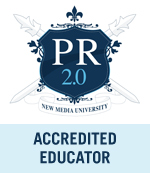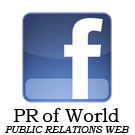We are closing up on the World Public Relations Forum 2010 in Stockholm. One of the challenges will be on co-creatiing The Stockholm Accords, a formal documentation on what PR is and does for an organization. This of course, is easier said and done.
A small conversation has already started and if you by any chance have read some of the comments under each section of The Stockholm Accords (Governance - Management - Sustainability - Internal - External - Coordination - References - Glossary - About), you will also find out- and inbound links to the on-going conversation.
First, I will acknowledge myself; I’m a practioner in a region with many respected international brands, a flourishing start-up scene, and world leading research in several fields. Especially if we take into account the relative “smallnes” of the Swedish, Scandinavian, and Nordic markets. I’m a thought leader when it comes to PR 2.0 in a region which more international companies should study more closely when it comes to early adopters, social media evolution, consumer behaviour, and communication technology deployment.
Furthermore, I have studied PR academically and practiced it professionally, and therefore I am more than familiar with the theorethical and practical pillars of our industry. I work at one of the largest and most prestigous strategic PR agencies in the Nordics, and I love PR.
And I will be damned if I am not going to have my say in this! :)
“Sustainability” vs. “The communicative organization”
In the model that keeps it all together, sustainability is the common ground for the different levels of the communicative organization. Dealing with transparency issues on a daily basis, it is to me clear that these are two different dimensions of the PR challenges that we are currently facing - and therefore one of them can not be presented as the baseline of organizational PR programmes while the other is not.
This is very important, because this “one-sidedness” is actually the main confusion when it comes to traditional vs. modern PR.
Sustainability is to be regarded as defensive measures such as issues management, crisis- and change communications, as well as an open-systems approach to publics, internal or external. The communicative organization is to be regarded as the art of letting go in a strategic manner. Letting go because it is good to do so from at strategic perspective.
My point is that an organization can not be communicative on all levels if the objective is to ensure (maintain?) sustainability. The human beings within and around the organization must be allowed to be irrational even when their actions or interests conflicts with what is regarded to be measures for sustainability at that particular point in time.
Human beings will say whatever they want to say about an organization, whether it is “sustainable” for the organization or not. This “Factor X” has to be taken into an account, and be seen as a driver of good to great PR; not something that has to be “controlled” or “changed” at any cost in order to ensure sustainability alone. The transition from mass-media to peer-to-peer-media shows us evidence of this shift all around us.
And what about PR programmes as a part of calculated risk-taking and competetive positioning? Today, young brands and brave organizations who are truly communicative in every fiber of their existence, can actually challenge their established competitors without traditional mass-marketing campaigns, just by simply being transparent and generously sharing. By creating long-lasting relations and trust through generosity, engagement, and by displays of true passion which can only be conveyed by human beings. This is the communicative organization, and for many parts it stands opposite the sustainable “avoid-risk-at-all-cost” PR programmes.
If PR wants to be a management tool, the organizational function needs to deserve it. It can not actually be claimed. Therefore, the strategic PR councel must be equipped to advice management on when to use communication for sustainability, and when to use it for calculated risk-taking.
And in short, the model misses the latter dimension of modern PR.
The different strategies for push and pull in modern PR
I constantly see a certain re-occuring pattern in every aspect of our profession, and it seems to be accelerated by our new digital realities. With this perspective, the pattern can be seen everywhere, and over time, I think this line of thinking will be the foundation of how PR strategies are being thought up in the years to come.
But first - some history of where we took a wrong turn: Some decades ago, the open-system approach PR model prevailed as a foundation for strategic communication. But all it really does, is emphasizing that the closed-system approach is bad, and that the PR function exists to help organizations aligning their operations with the irrationalities of the publics, and vice versa.
The PR function as “agents of change” sounds terrific if you are impressed by management terminology, but if you think about it, no matter if you change the organization and its operations, or the publics and their mindsets, how to choose between the two? Neither of them has to be wrong, nor must operational change or ideological public shifts be the only two solutions.
Let us instead forget about the management terminology for a while. Let us take a closer look at the communicative human being in relation to the organization; let us move from PR as a management function for sustainability through change to PR as cultivators of trust. From a stakeholder perspective, the human being is either an ambassador right now or something else. What thissomething else is could be debated, but let us leave them for now.
It is the individual ambassador that carries their very own brand interpretation, not the bulleted key messaging internal e-mails, nor the policy file cabinet in some HQ somewhere. These individuals are the real stakeholders, the real active publics, and they are right now.
Yes, sometimes organizational change is key. Sometimes creating ideological shifts by activating latent publics or changing the minds within a society is key. Yes. But right now? Is it not something we as PR professionals need to do first before changing the world, the industry, and the very business that we are in, or at least before we can deserve our seat at the management table?
Yes, there is. Fisrt and foremost we must acknowledge engagement. In most open-system- and issues management models, an organization’s loyal and loving publics are simply a potential problem already solved. From a sustainability perspective, these publics are not regarded as a PR problem, and left alone to do their thing, whatever it may be.
Does this mean that the PR industry has forgot about the ambassadors altogether? No, not quite. But there has been a prevailant PR tactic, a tactic with its origin in mass-media PR - outreach, publicity, push. It goes by many names, but it is what the organization wants to force upon its market.
And of course, this actually was the way to do it properly for a long time. Maybe you invited a couple of ambassadors to a focus group session, but that was mainly in order to get your mass communication messages just right. Many PR scholars spoke warmly about dialogue, mutual gains, and two-way symmetry. But the truth of the matter was, that the mass-media effects simply had the greatest ROI.
But today, as we all know, mass-media is not one-way anymore. You and everybody else can still reach the masses for sure, but with long tail- and sniper aim effects, it is now more than ever a question about what you want to achieve, rather than becoming known for what you think you are known for. Already accumulated trust, attention, and loyalty has suddenly become something more than just “not a PR problem right now”.
Today, they are the key competetive elements for the risk-taking communicative organization. I firmly believe, that without these somewhat overlooked or forgotten PR assets, there will not be any sustainability either.
PR must therefore take upon itself to safeguard, cater to, and actually also set the organizations ambassadors free. The organizations must be there for all their ambassadors who actually care for them right now. Provide them with what they seek. Listen to them. Help them becoming and expressing who they want to be in their value networks. This must be the first step, before pushing messages across societal networks.
Loose control - Gain influence.
Because it is only when the PR function can make sure the organization can manage their own pull effect, and only then the organization will be mature enough to push their messages. Because today, messages need to travel from peer-to-peer with of course makes the messaging stronger, but the fact of the matter is that your message will only be pushed by your ambassadors - and most likely by exactly no-one else.
The question of whether PR should act in favor of the organisatizon, the publics, or somewhere in between, thus becomes obsolete. Either it works for those it matters to, or it simply does not.
PR in a peer-to-peer society
A great PR programme of yesterday might be to place a pre-tested key message in the mass-media, reaching thousands of which a reasonable percentage is the organization’s target demographic. A great PR programme of today might be to gain and promote new, highly engaged ambassadors on a daily basis over a long period of time.
This is not to be mistaken for word-of-mouth marketing, viral marketing, or influential marketing. This is not about pushing messages to new audiences or shifting mindsets. This is about doing PR simply by taking greater care of those who already cares for you and your organization. Instead of regarding them as “a PR problem already solved”.
This evolution will force PR to work more closely to sales, human relations, customer service, and CRM.
And by gaining ambassadors one at time, the many minds can be influenced long-term by the truly passionate few.
And when you think about it - this new paradigm brought upon us by the peer-to-peer society matches what PR is all about perfectly - publics and relations!
But can The Stockholm Accords be a stepping stone towards such a reality? Let me put it this way; I am 30 years old, I have been passionately determined to change the way traditional PR has been done for some 10 years already, and I plan to fight a good fight for what I firmly believe that modern PR should be about - hopefully for another 70 years or so. For me the question is not whether The Stockholm Accords will reflect the realities of modern PR or not…
Given my line of reasoning, the key strategic question might actually be this one:
Will we - the many passionate young PR professionals who sees nothing but opportunity for our industry in this magnificent shift - will we be passionate and highly engaged ambassadors for The Sockholm Accords or will we choose not to be?
For my contribution, here are my feedback:
- The text must be much easier for its ambassadors to read, understand, and share amongst themselves
- The purpose must be more clearly stated from an outside-in perspective
- PR should not only be explained merely as a defensive and balancing tool (sustainability; agents of change), it should be explained as a part of business risk-taking (the communicative organization; empowering internal ambassadors) as well
- Since it is not all about aligning one with the other and the two-way symmetry open-system approach anymore, why not increase the focus on PR as a tool to engage the organization’s ambassadors?
- Get as much focus on pull as on push, and get them in the right order and context - we live in an era of sharing is caring and the advent of experts, important elements in the future of PR
- The attention economy works in favor for modern PR programmes, and this should of course be reflected in the text
See you there!
Note: The Twitter hashtag #PRofWorld explained.
Other postings:
- Stockholm Accords first draft up for comments. Please contribute, suggest, criticise and help shape the future of our profession
- PR people need cat food at the top table
- The Stockholm Accords interrogated, part 1
- The Stockholm Accords interrogated, part 2
- From Mexico to Stockholm


 Bli medlem i PR of Sweden!
Bli medlem i PR of Sweden!














{ 1 trackback }
{ 4 comments… read them below or add one }
Really enjoyed your post on this topic - and I think that your reflection on risk and PR's role in supporting organisations in this regard is very interesting. I think this applies not only internally but externally as many publics seem unsure about what risk involves and hence create crisis responses when what they see as unacceptable risk goes wrong.
I am thinking about how the public doesn't understand that, for example, driving a Toyota is no more risky than many other routine activities (even if you accept the claimed incidents which are not all proven in my view). If we want oil, then we need companies like BP to be engaged in riskier activities (albeit within a responsible framework). There was widespread resistance to the N1H1 vaccination programme because people were reluctant to take the risk (likewise with MMR vaccinations in the UK at least).
How do you feel this fits with your thesis?
My recent post PR people need cat food at the top table
First of all - thanks for getting through the text and a great comment! I appreciate it!
I think that public relations, if it claims "sustainability" as the overall single objective, actually deepens these conflicts. Some of us do not want to drive cars in traffic. Som of us do not want oil. Some of us do not want vaccinationations. But there is a lot of people who actually do.
My point here is that PR needs to acknowledge the ambassadors that they already have first before taking on the enormous tasks of creating various ideological shifts.
For instance with Toyota. They will suffer because of the allegations, of course. But there is still people out there who love Toyota. Who is smart enough to realize that getting into the car is a calculated risk to start with, And who realizes, that their cars probably will be safer than ever after recent events.
How do you take care of them in the best possible way? I ask rethorically because I believe their ambassadors are the ones who can restore the brand much more quickly and effective than any PR-strategy dealing solely with the issues at hand.
In the networked way of today, ther eis a multitude of individual opinions. And that is okay. As far as PR goes, you can not win them all. As a matter of fact, in order to be clear and to the point in your communication, you need to take a stand. There will always be groups of people who dislikes what you stand for, but chances are they will respect your brand for standing up for its beliefs.
I personally take risks, for example. I consume alcohol, even though I know it is bad for me. I do not want to be ambassador for a liquour brand going round telling everybody that my favourite brands are CSR-conscious. That to me is just a hygiene factor. But I do want the brand to actually see me, to acknowledge me somehow.
I guess that is sort of the way I would elaborate around it. If a public have a distorted view on what risks to take and not, the best way to convey this message to them is to support those publics who on their own has reached the same conclusion as the company. And begin from there.
We had the N1H1 trust issues in Sweden as well, by the way. That is a really interesting case to study from a PR perspective!
I have to agree with Doktor Spinn. However, he is not telling the PR Community - especially those who practice in both Europe and USA anything new. What has surfaced is the fundamental change in the economic climate which has forced PR to ensure that it has to work more closely with the hard management functions of business inclusive of the area of "sustainability." Otherwise, PR will be weedled out and the creeping (and philistine) role of HR will attempt (as seen in the UK) to take over and attempt to define the professionalism of PR. This must not happen….
"Otherwise, PR will be weedled out and the creeping (and philistine) role of HR will attempt (as seen in the UK) to take over and attempt to define the professionalism of PR. This must not happen…."
Very interesting point, thanks for sharing!